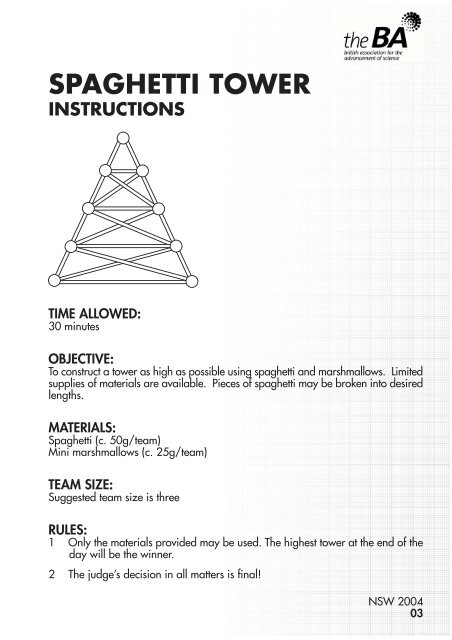Spaghetti Tower Instructions
Spaghetti Tower Instructions
Spaghetti Tower Instructions
You also want an ePaper? Increase the reach of your titles
YUMPU automatically turns print PDFs into web optimized ePapers that Google loves.
SPAGHETTI TOWER<br />
INSTRUCTIONS<br />
TIME ALLOWED:<br />
30 minutes<br />
OBJECTIVE:<br />
To construct a tower as high as possible using spaghetti and marshmallows. Limited<br />
supplies of materials are available. Pieces of spaghetti may be broken into desired<br />
lengths.<br />
MATERIALS:<br />
<strong>Spaghetti</strong> (c. 50g/team)<br />
Mini marshmallows (c. 25g/team)<br />
TEAM SIZE:<br />
Suggested team size is three<br />
RULES:<br />
1 Only the materials provided may be used. The highest tower at the end of the<br />
day will be the winner.<br />
2 The judge’s decision in all matters is final!<br />
NSW 2004<br />
03
SPAGHETTI TOWER<br />
BUILDING HINTS AND TIPS<br />
There are many ways of building towers using spaghetti and marshmallows. These<br />
notes are intended not as instructions, rather as points to think about in developing<br />
the design.<br />
TOP TIPS!<br />
1. Make sketches of any good ideas you have and make plans for how you will<br />
construct the tower – good planning and design are essential to building a<br />
successful tower!<br />
2. Where you choose to use shortened pieces of spaghetti, make sure you cut<br />
them accurately. If you don’t use pieces of equal length in a particular section<br />
of the tower, it may start to twist and topple.<br />
3. Use shorter pieces of spaghetti or put in braces (triangular supports) to help<br />
support squares or rectangles in your tower.<br />
4. Think carefully about whether the spaghetti should pass all the way through<br />
the marshmallow, or not…… Remember that the strength of a joint is dependent<br />
on how well the marshmallow can ‘grip’ the spaghetti strand without it slipping.<br />
5. There will be most stress at the base of the tower – think about how to add<br />
strength here.<br />
NSW 2004<br />
04
SPAGHETTI TOWER<br />
BUILDING HINTS & TIPS - more detail<br />
1. THE BUILDING MATERIALS<br />
Although spaghetti and marshmallows don’t seem like strong building materials, you can<br />
build surprisingly elegant and sturdy structures using them. The spaghetti provides the<br />
framework and support for the tower, the mini-marshmallows are used to make connectors.<br />
The important thing to realise is that the marshmallows “grip” onto the pieces of spaghetti<br />
to hold the joints in place. The strength of a joint is dependent on how well the marshmallow<br />
can hold the spaghetti strands without them slipping. If there is a heavy load (weight) on<br />
the joint it may cause the marshmallow to “creep” or change shape until the joint fails -<br />
this is most likely to happen where the load is the greatest, i.e. at the bottom of the tower.<br />
2. MAKING STRONG SHAPES<br />
The shapes that are used to build strong structures are very important. Think about the<br />
shapes that have been used to construct bridges and towers that you have seen or know<br />
about. Start to practice building with spaghetti and marshmallows by testing out different<br />
basic shapes such as squares and triangles. You will discover that squares collapse easily<br />
under compression. Four pieces of spaghetti joined in a square give way at their joints –<br />
the weakest points. But, if you make a spaghetti triangle, the situation changes. To make<br />
the triangle collapse you have to push very hard. You can build very large structures from<br />
squares and cubes, but they will be weak and will usually fall down quite easily. If you<br />
try to make a structure out of triangles and pyramids, it will be strong but you will use a<br />
lot of materials before the tower gets very tall! The best way to build a tall tower is to use<br />
both triangles and squares – that way you can build big structures that are less wobbly.<br />
A diagonal piece of spaghetti put across a square turns a square into two triangles and<br />
makes it more rigid.<br />
3. COMPRESSION AND TENSION – SOME BASIC PRINCIPLES<br />
Even though a tower you build may be standing perfectly still, the individual parts are always<br />
pushing and pulling on each other. Large structures remain standing because some parts are<br />
being pulled or stretched (tension members) at the same time as others are being pushed or<br />
squashed (compression members). The vertical pieces of spaghetti in your tower will be in<br />
compression, and the compression will be greatest at the base of the tower. The horizontal<br />
and diagonal pieces of spaghetti in the tower may be in tension. The strength of these tension<br />
members will not depend on how strong the spaghetti is, but on how well the marshmallows<br />
can grip it (and hold it in place). The marshmallows are most likely to change shape and fail<br />
at the bottom of the tower, where there is most weight on them (from the compression and<br />
tension members).<br />
N.B. To make this challenge slightly easier the race organiser could provide a small<br />
number of LARGE (e.g.four per team) marshmallows to incorporate into the base of<br />
the tower.<br />
NSW 2004<br />
05
Here are some examples


